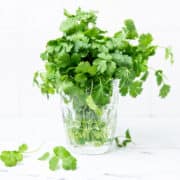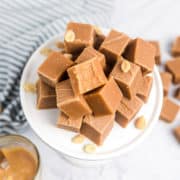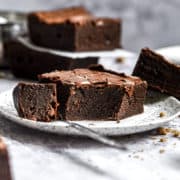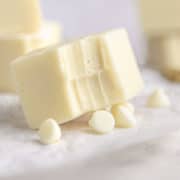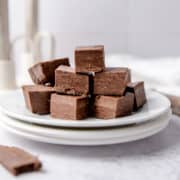Cilantro is one of those herbs people either love or hate. Personally, I love the fragrant flavor of this versatile herb and like to add it to all kinds of dishes, especially when preparing Asian or Mexican cuisine. Fresh herbs like cilantro aren't difficult to keep fresh, but they don't have a long life expectancy like their dried equivalent. Once you know how to store cilantro though, you will always want to keep some handy to liven up your home-cooked meals.

Jump to:
While some people find cilantro offers a citric, tart flavor, others claim it tastes soapy! Interestingly, the reason behind this is about 25% of people have a specific gene that makes it taste different to them.
Cilantro can be added to recipes or used as a garnish for savory snacks and meals. It isn't usually added to a recipe during cooking because the heat will quickly destroy the distinctive aroma and flavor.
This herb contains Vitamins A, C, and K. Folate, potassium, and manganese is found in the cilantro leaves as well. It’s not only a healthy option, but cilantro is nutritious too.
Try it sprinkled over homemade food processor salsa or tacos, combine it with lime juice to make a tasty seasoning for grilled chicken or fish, or add it to homemade soups and sauces. Even if you are among the 1 in 4 who don't like cilantro, it still makes a bright, appealing garnish for many different dishes.
What is Cilantro?
Cilantro (Eryngium Foetidum) is an herb with bright green leaves. It looks similar to parsley, but the leaves are softer in shape. This herb is known in some places as Chinese parsley, Mexican parsley, or fresh coriander. The plant grows up to 20 inches tall. This herb can be traced all the way back to 2000 BC and is native to a large part of Southern Europe as well as Western Asia.
Cilantro can be grown on the kitchen windowsill, but I usually have more success with basil and parsley, which are hardier. It can also be grown outside but it dislikes the cold.
There are several types of cilantro, including Indian summer cilantro, leaf cilantro (the most common kind in grocery stores), Mexican coriander, potluck coriander, and Vietnamese coriander. They all taste very similar but you will need to head to an Asian or ethnic market to find some of these.
Tips for Buying Cilantro
Choose cilantro which is bright green. Brown or yellow leaves indicate spoilage. Fresh cilantro should have a citrusy, earthy smell. If it smells dank, reject it. Cilantro stems and leaves should be sturdy enough to stand up rather than mushy or limp.

How to Store Cilantro
The best way to store cilantro from the grocery store depends on whether you are buying a plant or a bunch of cilantro, as well as when you're planning to use it.
- A cilantro plant will be happy on a warm windowsill or on the kitchen counter at room temperature. Simply snip off what you need and give it water when the soil feels dry. Don't water if there's still excess moisture in the soil. If you're somewhere with no chance of frost in the immediate future, you could also keep it outside.
- A bunch of cilantro lasts longer if you remove the bottom of the stem with a sharp knife and keep it in a glass of water, just like with a bouquet of flowers. Half-fill a mason jar or glass with fresh water (or add at least an inch of water) and put the cilantro stem end down in the water. Either leave the rubber band on or remove it. Optionally, cover it with a plastic bag. Since cilantro likes cool temperatures (unlike basil, for example) it will do well in the refrigerator. I change the water every few days or whenever it goes cloudy.
- You can also freeze cilantro and this is a great way to extend its life. I like to do this with fresh leaves, but you can also freeze the stems as they are also edible. Wash it, dry it with paper towels, and put it in freezer bags in a single layer. You can then freeze it. Another method is to freeze it in olive oil as ice cubes in ice cube trays. Or freeze the stalks in a fresh layer and transfer them into an airtight container or zip-top freezer bag. You can snap however much you need off the frozen stems whenever you need it and freezing doesn't make it lose too much flavor.
Store fresh cilantro in the refrigerator and it should be fine for up to 2 or maybe even 3 weeks. In the freezer, it should be fine for months and you can simply drop a frozen cilantro ice cube into your meal rather than adding fresh.
How to Tell if Cilantro has Gone Bad
With most fresh herbs, including cilantro, you should be able to see when they're past their best. Spoiled fresh cilantro will turn yellow and then brown. The texture will change from firm to mushy.
If only some of the cilantro looks or smells bad, discard that and use up the remainder of this fresh herb as soon as you can. Slightly wilted cilantro can be submerged in icy water for 2 or 3 minutes to revive it. Interesting, this tip works for lettuce also!
Common Questions
Since this would depend on the recipe you're making, it depends. If the cilantro is simply for garnish, you can just omit it. Otherwise, consider fresh mint or Thai basil in an Asian recipe or parsley and/or dill in a seafood dish. You can also just leave it out of your recipe altogether.
At the time of writing, I have a bunch of basil sitting in a half-filled glass of cool water in the refrigerator and it's been there for nearly a month! I like to keep it at the back of a shelf where it's coolest and change out the water every 3 or 4 days. Your results might vary!
Don't rinse cilantro until just before using it, then rinse under cold running water and shake off the excess water. You can also dry this delicate herb in a salad spinner. Rinsing is recommended in order to remove any dirt, chemicals, bugs, or sand.

Interesting Facts
- Cilantro and coriander come from the same plant. Cilantro is called "fresh coriander" in the UK, Europe, and some other countries. Coriander typically refers to the seeds from the cilantro plant. Cilantro is considered an herb while coriander is considered a spice.
- Cilantro is the only herb that 1 in 4 people don’t like! This is because some people have a gene that makes cilantro taste like dish soap to them.
- The tallest cilantro plant, according to the Guinness Book of Records, reached a whopping 7 feet 6.11 inches.
Cilantro is a popular herb with a unique flavor profile. When you know how to store cilantro, the good news is it should last for a relatively long time. The leafy herbs offer a distinctive, bright flavor that complements a wide range of savory recipes.
